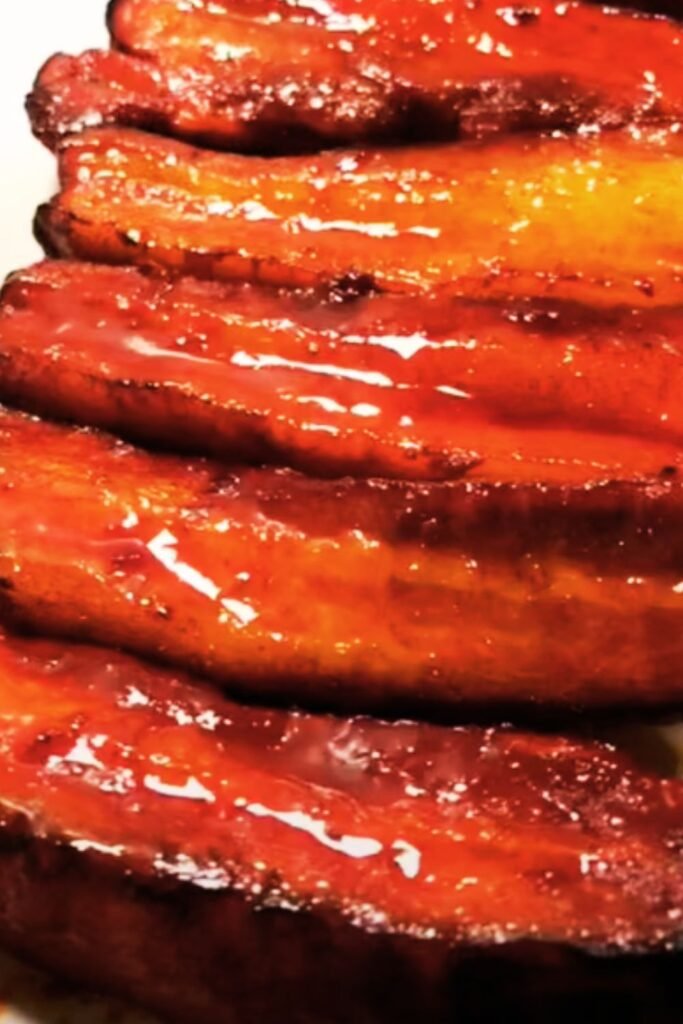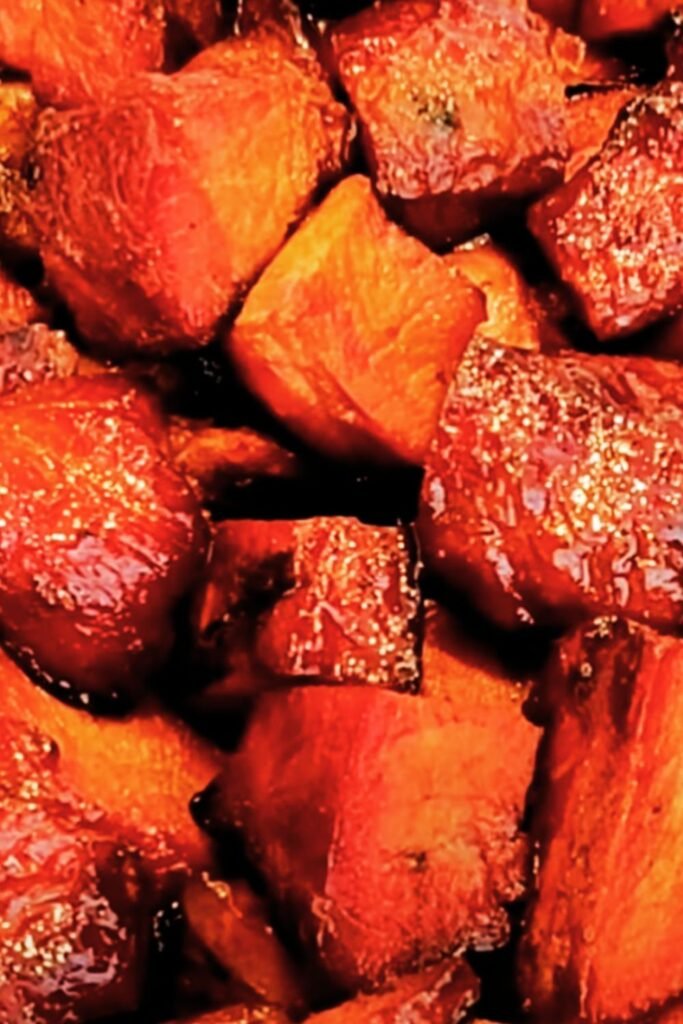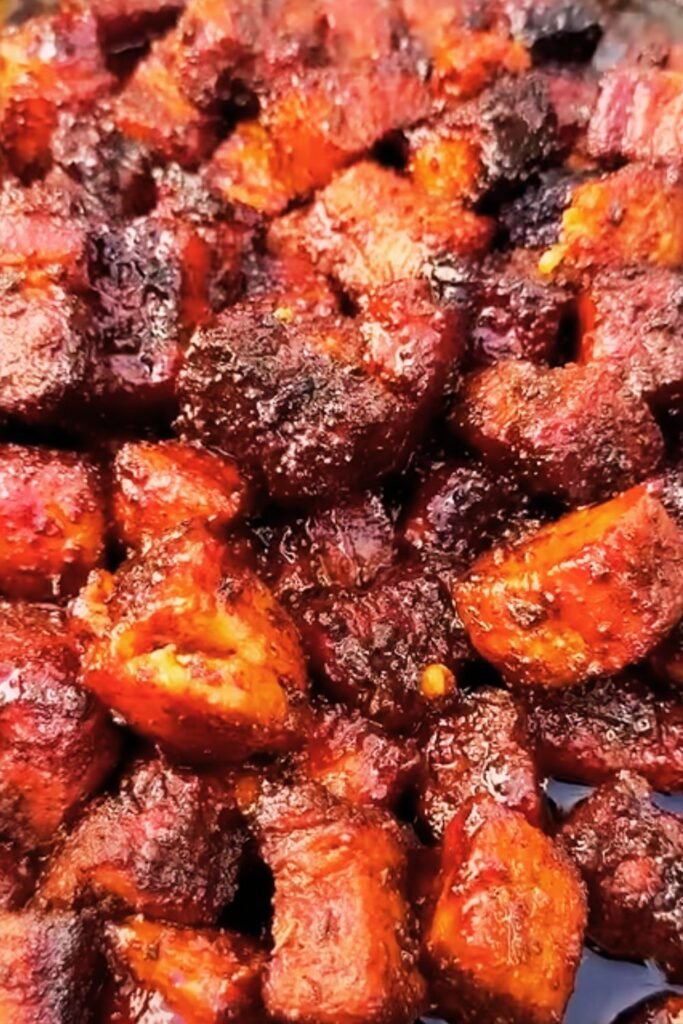There’s something magical about that first bite of perfectly caramelized, sweet-savory Chinese barbecue pork. The glistening red exterior giving way to juicy, tender meat that melts in your mouth. I’ve spent years perfecting my char siu recipe, and today I’m sharing all my secrets for creating this iconic Cantonese delicacy right in your own kitchen.
Char Siu (叉烧), literally meaning “fork roasted,” has been a cornerstone of Chinese cuisine for centuries. While traditionally made with pork shoulder or loin, using pork belly elevates this dish to sublime new heights. The layers of fat render slowly during cooking, basting the meat from within and creating that perfect balance of succulence and texture that makes this version truly special.
What Makes Great Char Siu?
Before diving into the recipe, let’s understand what makes exceptional char siu:
- The perfect balance of sweet, savory, and umami flavors
- That signature red hue (traditionally from red fermented bean curd, though many modern recipes use food coloring)
- A lacquered, caramelized exterior with a tender, juicy interior
- Complex depth of flavor from Chinese five-spice, honey, hoisin sauce, and other aromatics
The beauty of making char siu at home is that you can control every element. No artificial colors needed, no excessive sweeteners—just pure, authentic flavor that rivals (and often surpasses) what you’ll find at Chinese barbecue shops.
Ingredients for Perfect Pork Belly Char Siu
For the Marinade:
- 2 lbs pork belly, skin removed (in one piece)
- 3 tablespoons honey
- 2 tablespoons hoisin sauce
- 2 tablespoons Shaoxing wine (Chinese rice wine)
- 2 tablespoons soy sauce
- 1 tablespoon dark soy sauce (for color)
- 1 tablespoon oyster sauce
- 1 tablespoon sesame oil
- 2 teaspoons five-spice powder
- 1 tablespoon garlic, minced
- 1 tablespoon ginger, grated
- 1 teaspoon white pepper
- Optional: 2 pieces of red fermented bean curd (for authentic color and flavor)
For the Glaze:
- 3 tablespoons honey
- 1 tablespoon hoisin sauce
- 1 tablespoon hot water
Essential Equipment
Having the right tools makes all the difference when preparing char siu:
- Roasting pan with rack
- Aluminum foil
- Meat thermometer
- Basting brush
- Large zip-top bag for marinating

Preparation Method
Step 1: Prepare the Pork Belly
I always start with the meat preparation, which is crucial for the perfect result:
- If your pork belly has skin on, remove it carefully with a sharp knife (save it for crackling in another dish!).
- Cut the pork belly into strips about 2 inches wide and 8 inches long. This size allows for even cooking and maximum flavor penetration.
- Using a fork or meat tenderizer, poke small holes throughout the meat. This helps the marinade penetrate deeper.
Step 2: Create the Marinade
The marinade is the heart and soul of char siu:
- In a bowl, combine all marinade ingredients and whisk until thoroughly mixed.
- If using red fermented bean curd, mash it with a fork before adding to the marinade.
- Place the pork strips in a large zip-top bag and pour the marinade over them.
- Seal the bag, removing as much air as possible, and massage the marinade into the meat.
- Refrigerate for at least 24 hours, ideally 48 hours for maximum flavor development. Turn the bag occasionally to ensure even marination.
Step 3: Roasting to Perfection
- Remove the pork from the refrigerator 1 hour before cooking to allow it to come to room temperature.
- Preheat your oven to 350°F (175°C).
- Line a roasting pan with foil (for easier cleanup) and place a rack inside.
- Remove the pork from the marinade, saving the liquid. Pat the pieces dry with paper towels.
- Place the pork strips on the rack, ensuring they don’t touch each other.
- Pour about 1 cup of water into the pan beneath the rack (this prevents burning and keeps the oven environment humid).
- Roast for 25 minutes, then flip the pork.
- Meanwhile, combine the reserved marinade with 1/4 cup water in a small saucepan. Bring to a boil, then simmer for 5 minutes to create a basting sauce.
- After flipping, baste the pork generously with the reduced marinade.
- Continue roasting for another 20-25 minutes, basting every 10 minutes.
Step 4: The Final Glaze
The magic happens in these final steps:
- Mix the glaze ingredients together in a small bowl.
- Increase the oven temperature to 425°F (220°C).
- Brush the pork liberally with the honey glaze.
- Return to the oven for 5-8 minutes, watching carefully to prevent burning. The pork should develop a beautiful caramelized exterior.
- Once the internal temperature reaches 160°F (71°C) and the outside is glossy and charred in spots, remove from the oven.
- Let rest for 10-15 minutes before slicing to allow the juices to redistribute.

How to Know When Your Char Siu is Done
Perfect char siu requires hitting the sweet spot between undercooked and dry. Here’s my fail-proof method:
| Visual Cues | Temperature | Texture Check | Timing (for 2″ thick pieces) |
|---|---|---|---|
| Caramelized exterior with charred edges | 160°F (71°C) internal temperature | Meat feels firm but yields to pressure | 50-60 minutes total roasting time |
| Deep mahogany color | Fork easily penetrates meat | ||
| Clear juices when pierced |
Secret Pro Tips
After years of making char siu, I’ve developed these tricks that make all the difference:
- Don’t skip the marinade time – 48 hours makes a world of difference in flavor penetration
- Mix sweet and dark soy sauce – This gives depth of color without artificial additives
- Multiple glazing passes – Apply at least 3 coats of glaze during the final roasting phase
- Let it char (a little) – Those slightly blackened edges are full of flavor
- Rest before cutting – This keeps your char siu juicy and prevents moisture loss
Serving Suggestions
The versatility of char siu is one of its greatest attributes. Here are my favorite ways to enjoy it:
As a Main Dish:
- Sliced and served with steamed rice and Chinese greens
- Accompanied by a simple cucumber salad dressed with rice vinegar and sesame oil
- Paired with congee (rice porridge) for a comforting meal
In Classic Combinations:
- Char Siu Bao (stuffed in fluffy steamed buns)
- Wonton noodle soup with char siu topping
- Fried rice studded with diced char siu
- Lo mein or chow mein with sliced char siu

Make-Ahead and Storage Tips
Char siu actually benefits from being made in advance. Here’s how to store it properly:
Refrigerator Storage:
- Cool completely before refrigerating
- Wrap tightly in plastic wrap or store in an airtight container
- Keeps for up to 4 days
- Slice only what you need, keeping the remaining piece whole to retain moisture
Freezer Storage:
- Wrap individual portions in plastic wrap, then foil
- Place in freezer bags with air removed
- Freeze for up to 3 months
- Thaw overnight in the refrigerator before reheating
Reheating Methods:
- Steaming (preferred): Place slices in a steamer for 3-5 minutes to restore moisture
- Microwave: 30 seconds at medium power with a damp paper towel covering
- Oven: Wrap in foil and heat at 300°F for 10 minutes
Adapting the Recipe
While this recipe represents the traditional approach to char siu, I understand that ingredients and dietary preferences vary. Here are some thoughtful adaptations:
Ingredient Substitutions:
- Shaoxing wine: Dry sherry or sake (though the flavor will be slightly different)
- Red fermented bean curd: 1 tablespoon red food coloring mixed with 1 tablespoon miso paste
- Dark soy sauce: Regular soy sauce with 1/4 teaspoon molasses
- Five-spice powder: Make your own with equal parts star anise, cloves, cinnamon, Sichuan peppercorns, and fennel seeds
For a Leaner Version:
- Use pork tenderloin instead of belly (reduce cooking time to 30-35 minutes total)
- Substitute half the honey with pureed dates for natural sweetness
For a Spicier Kick:
- Add 1-2 teaspoons of chili oil to the marinade
- Include 1/4 teaspoon of white pepper for subtle heat
- Serve with homemade chili sauce on the side
Why Homemade Char Siu Beats Restaurant Versions
I’ve tasted char siu all over the world, from Hong Kong’s renowned roasted meat shops to Chinatowns across America. Making it at home offers distinct advantages:
- No artificial colors or preservatives – Many restaurants use food coloring and MSG
- Control over sweetness – Commercial versions often use excessive sugar
- Premium meat selection – You choose the quality and cut of pork
- Freshness factor – Enjoy it straight from the oven at peak flavor
- Customizable flavor profile – Adjust the five-spice, saltiness, and sweetness to your preference
The Cultural Significance of Char Siu
In Chinese culture, char siu represents more than just delicious food. It’s a celebration dish, often featured during family gatherings and festive occasions. Traditionally, char siu was made by Cantonese barbecue masters who guarded their recipes closely, passing them down through generations.
The distinctive red color was historically associated with good fortune and celebrations. In modern Chinatowns worldwide, restaurants with hanging char siu in the window signal authenticity and culinary mastery.
By making char siu at home, you’re connecting with this rich culinary heritage while creating your own tradition of sharing exceptional food with loved ones.
Troubleshooting Common Issues
Even experienced cooks sometimes encounter challenges with char siu. Here are solutions to common problems:
| Problem | Possible Cause | Solution |
|---|---|---|
| Meat too dry | Overcooked or lean cut used | Use fattier cuts; reduce cooking time; baste more frequently |
| Not enough color | Insufficient glazing or missing dark soy sauce | Add more dark soy to marinade; apply more glaze layers |
| Too sweet | Too much honey or hoisin | Reduce sweeteners by 25%; increase soy sauce slightly |
| Burnt exterior, raw interior | Oven too hot | Lower temperature; cook longer at 325°F before final glazing |
| Flavor didn’t penetrate | Insufficient marination time | Marinate longer; score meat before marinating |
Frequently Asked Questions
Q: Can I use other cuts of pork for char siu? Absolutely! Pork shoulder (butt) works wonderfully and is traditional. Pork loin is leaner but can work if you’re careful not to overcook it. Each cut will give slightly different results, with pork belly offering the richest, most succulent texture.
Q: Is there a way to make this dish less sweet? Yes, simply reduce the honey in both the marinade and glaze by half. You can also skip the final honey glaze altogether and just rely on the caramelization of the marinade for flavor and color.
Q: How can I get that restaurant-style red color without food coloring? The combination of dark soy sauce and red fermented bean curd will give you a beautiful natural color. The long marination helps this color develop. For deeper red, you can add a small amount of beet powder to your marinade.
Q: Can I use this marinade for other meats? This marinade works beautifully with chicken thighs and duck breast as well. For chicken, reduce the marination time to 24 hours maximum. For duck, follow the same timing as pork.
Q: I don’t have an oven rack. Can I still make char siu? Yes! You can create a makeshift rack with aluminum foil rolled into cylinders, or use a broiler pan. In a pinch, you can even use clean chopsticks arranged across a baking dish. The key is allowing air circulation around the meat.
Q: How do I know if my pork belly is cooked properly without a meat thermometer? Insert a metal skewer into the thickest part of the meat and hold it there for 5 seconds. Remove it and touch it carefully to your lower lip. If it feels hot, the meat is done. You can also check that the juices run clear when the meat is pierced.
Q: Can I grill char siu instead of roasting it? Absolutely! Grill over indirect medium heat (around 350°F) for similar timing as the oven method. Move to direct heat for the final few minutes to caramelize the glaze. Watch carefully to prevent burning.
Q: What makes char siu red in restaurants? Traditionally, red fermented bean curd (nam yue) provides color and flavor. However, many commercial establishments use red food coloring. My recipe relies primarily on dark soy sauce and the natural caramelization process for a beautiful color without artificial additives.
Final Thoughts
Creating authentic char siu at home is both an art and a science. The time invested in marination and careful cooking pays dividends in flavor and satisfaction. There’s something deeply rewarding about mastering this iconic dish—seeing the glistening, caramelized exterior, catching that first whiff of five-spice and honey, and finally cutting into perfectly juicy meat.
I hope this guide helps you create char siu that rivals the best Chinese barbecue shops. Remember that each batch gets better as you fine-tune the process to your preferences. The journey of perfecting your char siu recipe is as enjoyable as the destination.
Now, it’s time to gather your ingredients, prepare your marinade, and embark on your own char siu adventure. Your kitchen will soon be filled with the intoxicating aromas of authentic Chinese barbecue, and your friends and family will be begging for your secret recipe.